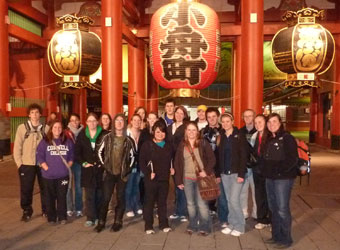Sociology and psychology students study Japanese culture firsthand
During Block 7 2010, students traveled to Japan to study the interconnections between Japanese cultural traditions, gender roles, and contemporary public policy.The course was co-led by Associate Professor of Sociology Erin Davis and Professor of Psychology Carol Enns.
 The class traveled within the Tokyo and Kyoto-Osaka regions, visiting many historical, cultural, educational, employment, and religious settings to gain first-hand understandings of Japanese traditions, values, and everyday life. During the course, students contributed to a class journal documenting their impressions of Japanese gardens, tea ceremonies, baseball games, communal baths, etc.
The class traveled within the Tokyo and Kyoto-Osaka regions, visiting many historical, cultural, educational, employment, and religious settings to gain first-hand understandings of Japanese traditions, values, and everyday life. During the course, students contributed to a class journal documenting their impressions of Japanese gardens, tea ceremonies, baseball games, communal baths, etc.
Gardens and wrapping
Wrapping is an important feature of gardens and Japanese society. Japanese people wrap themselves in their private worlds in public by playing with phones or iPods on the subway; they wrap their private lives in the public world by surrounding gardens and personal living space with walls and outer rooms. Food and other valuable items such as gifts, buildings, and even bodies are wrapped in fabric to protect what is wrapped. Gardens are wrapped in many ways, as they are typically hidden behind tall walls or bushes so that the beauty within cannot be seen from the outside. The visitor to the garden is wrapped within the garden, as small fences or hedges confine them to a trail. Gardens are wrapped within cities as small islands of paradise; even within gardens, various aspects are wrapped away from each other.
Mountain temples
Today we took an amazing hike through the forest over Mt. Kumara. Along the way we encountered many Shinto shrines and a Buddhist temple … Shinto shrines were distinguishable by their emphasis on viewing gods within nature and on integration of worship with nature … water and trees and stone are often integrated into the very structure of the shrine.
Baseball
Baseball works as a manifestation of wa-the harmony between all things. Everyone has a given job to do, and if they do it properly, the team will succeed. However, the success of the team is still subject to the harmony of the outside world-a game must end after three hours and 20 minutes, even if it is a tie game. There are designated “superfan” sections … these fans wave giant flags, sing songs for each batter as he comes up to the plate, and perform choreographed cheers in unison. However, in deference to wa, when the other team is at bat, they do not jeer but sit quietly.
Hair salons
The Japanese salon experience reflects the Confucian principle of adherence to ritual and, more specifically, a respect for the kata. The right and proper way of doing something (kata) is very apparent in the work of the stylist. The hair cut is treated as an almost artistic expression. There are set procedures for each step of the process, from rinsing properly to a good head massage-everything has a form to follow.
Uniforms
Throughout Japan, everyone wears a uniform. This uniform is very important to the Japanese belief system, specifically Confucianism … This allows an individual to quickly identify who are peers and who is below or above them. This easy identification system ensures that a person shows the proper level of respect and uses the proper conduct and rituals with a person.
Cleaning ladies
The cleaning ladies in their bubblegum pink uniforms and white gloves stand at the ready for the train to arrive. As it pulls in, they climb aboard, quickly scrubbing everything down in order to make the train ready for the next busy customers. The cleaning ladies wear stellar examples of uniforms in action. This form of wrapping designates the women for the particular job, right down to the wrapping (protected/closed off) nature of the white gloves. This example also serves as a reflection of the Japanese aesthetic eye-the bright, cheery pink of the uniforms reflects the rosy, idealized nature of train travel.
Tea ceremony
… she then prepared the tea and put a cup in front of each person individually, and we all bowed. We then held the cups in our left hands, and each time we took a drink we rotated the cups with our right hands. The cups had indentations in them, and when we finished, we placed the cups in front of us with the indentations facing away from us. As she collected the cups, we bowed. After she removed most of the tea from the room, she bowed to us and we bowed back as she made her exit.
Communal baths
I was impressed by the comfort of women with their bodies. I felt completely awkward being nude … these women, however, were not fazed by it at all. It shocked me because Japanese tend to be private whereas Americans seem so open about their feelings and talking about sex and such.



